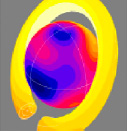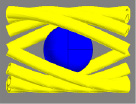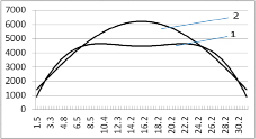Hardening is widely used in the production of various parts. Such technological operations are subject to the requirements of repeatability and high heating accuracy with minimal deviations from the required temperature [1].
The production of ball bearings is one of the most mass productions. In the production of bearings, hardening is one of the main technological operations, since the heat treatment of products greatly affects the efficiency and durability of bearings, so the development of high-performance and efficient heating equipment is a very urgent task [2].
As you know, at present the most advanced and progressive method of heating is induction heating. Induction plants are environmentally friendly; they occupy a small production area, are easily integrated into automatic production lines, and are relatively easy to automate. Due to these qualities, inductors are used for heat treatment of a wide range of various shapes products.
Induction heating of a spherical surface is associated with certain difficulties. The main problem is to ensure the uniformity of heating during hardening. The second equally important problem is the achievement of high efficiency of the induction installation. If the design and shape of the inductor play a decisive role in ensuring the heating efficiency, the uniform heating can be obtained using various types of workpiece movement. This can be, for example, translational motion that is scanning heating for uniform heating along the length of the workpiece or shaft rotation to compensate for uneven heating from an asymmetric shaft location in the inductor.
For spherical shapes, the task is complicated by the fact that the ball must be rotated in two mutually perpendicular directions. This requires either a significant complication of the inductor design, which provides complex rotation of the ball when it rolling along the inductor, or the use of special methods for holding the ball in space to give it the required direction of rotation.
In, the possibility of improving the uniformity of heating is shown when using the rotation of a single-turn inductor in addition to the rotation of the ball (Fig. 1). The technical difficulties of supplying cooling water and high currents to a rotating inductor make this method of heating practically unrealizable.

Fig. 1. The sketch of a single-turn inductor for hardening balls
In [3], a way to solve the practically unsolvable problem of inductor rotation is shown. The inductor consists of one or more inductive conductors; each of them has the cylindrical helix shape. Heating in the inductor of the proposed design does not occur simultaneously from all sides, but in a certain area of electromagnetic interaction between the inductor and the ball. The heated ball is rolled through the inductor, while the electromagnetic field, due to the specific shape of the inductor, moves along the surface of the ball. The special shape of the inductor [4] makes it possible to change the position of the inductive conductor relative to the ball, thereby providing the effect of a rotating inductor when the ball rolls along the stationary inductor (Fig. 2). The trajectory of the electromagnetic interaction area on the sphere, which moves at a constant speed along the axis of ball rotation and simultaneously rotates with a constant angular velocity around this axis, can be defined as a spherical helix with a uniform step.

Fig. 2. Inductor in the cylindrical helix form
This article is devoted to the study of a screw inductor in order to obtain a design that provides the highest possible uniformity magnetic field to ensure the uniformity heating and quality of hardening.
Obviously, the uniformity of heating is achieved with a uniform distribution of the induced power over the surface of the ball, which in turn is ensured by a uniform magnetic field strength over the ball surface. Therefore, studies on the dependence of the magnetic field configuration on the design and energy parameters of the inductor were carried out.
Materials and methods of research
The research was carried out using a computational experiment. For this purpose, the Cedrat Flux software package was used which designed to calculate fields of various physical natures [5].
The computational experiment was carried out under the following conditions:
− Number of inductive conductors from 1 to 4;
− Material of ball Steel ШХ15
− Ball diameter 20mm
− Tube inductor Copper M1
− Outer tube diameter 5mm
− Tube inner diameter 3mm
− Ball rotation speed 10 rpm
− Two axisymmetric located inductors[6]
− The voltage on the inductor was chosen from the condition of the same current density in the inductor j=150 A/mm2.
Three options for switching on the inductor tubes are considered (Fig. 3):
− Parallel connection of all tubes, then "+" (fig. 3a)
− Series connection of inductive conductors bundles with parallel connection of tubes in the bundle, hereinafter referred to as "-" (fig. 3b)
− Sequential connection of all tubes (Fig. 3c)
Results of the research and discussions
The study of tube switching circuits showed that when the inductive conductors were switched on according to option c) in Fig. 3, the magnetic field turned out to be the weakest, and this option was not considered further, and options a) and b) gave almost the same result.
The study of connection schemes revealed an additional effect from the interaction of inductor currents.

а) b) c)
Fig. 3. Direction of currents in inductive conductors in various switching schemes
When inductive conductors switched on according to the scheme of Fig. 3a, the eddy currents in the ball are distributed along the large circle of the ball, which lies in the plane of the cross section of the inductor (Fig. 4a). When inductive conductors switched on according to the scheme of Fig. 4b, the eddy currents in the ball are distributed along the large circle of the ball, which lies in the plane of the longitudinal section of the inductor (Fig.4).

а)

b)
Fig. 4. Distribution of eddy currents with different connection of inductive conductors bundles. a) parallel connection, b) series connection
In both cases, an eddy current ring is formed. Further, for brevity, it will be called the longitudinal ring and the transverse ring of ball currents.
The figure 4 clearly shows the difference in the distribution of currents along the ring, clearly uneven in the transverse and much more uniform in the longitudinal.
The position of the transverse ring relative to the ball does not change, although it rotates during heating following the inductive conductors, which change their position relative to the ball as it rolls along the inductor. This causes overheating of some areas of the ball. The longitudinal current ring also rotates, but its rotation causes a change in its position relative to the ball, similar to a change in the relative position of the inductor.
Thus, instead of the supposed displacement of the zone of interaction between the inductor and the ball with the formation of a heat trace in the form of a spherical helix on its surface, we obtain the rotating eddy current ring, similar to the rotating single-turn inductor, enveloping the ball in a large circle [7].
The degree of mutual influence of currents in inductive conductors from the different electrical circuit connection has been studied. The computational experiment showed a noticeable redistribution of current between the inductive conductors. To reduce the redistribution of current, a model was studied with separate connection of the inductive conductors in the bundle to individual power sources while maintaining a current density of 150A/mm2.
With the same voltage on the tubes equal to the voltage when the tubes are connected in parallel, uneven distribution of currents between inductive conductors has not changed.
To equalize the current density in the inductive conductors, the voltage on the middle tubes was increased by 1.7 times (Table 1).
After compensating of the currents redistribution, the magnetic field strength increased from 4544 A/m to 6033 A/m, but at the same time, the power distribution over the surface of the ball became significantly uneven (Fig. 5).

Fig. 5. Change in the magnetic field strength on the surface of the ball along the great circle: 1 – current displacement effect is not compensated, 2 – current displacement effect is compensated
Table 1
Voltages and currents in inductive conductors without current redistribution compensation (U1, I1) and with compensation (U2, I2)
|
1 |
2 |
3 |
4 |
|
|
U1 [В] |
0,8157 |
0,8157 |
0,8157 |
0,8157 |
|
I1 [А] |
393 |
255 |
255 |
393 |
|
I2 [А] |
277 |
478 |
478 |
277 |
|
U2 [В] |
0,8157 |
1,15 |
1,15 |
0,8157 |
The experiment showed the correlation between the redistribution of currents in the inductor and the uniformity of the distribution of the magnetic field over the ball surface. The phenomenon of redistribution of currents equalizes the magnetic field on the surface of the ball.
Conclusions
A specially designed induction heating plant for hardening balls for bearings has been investigated.
A series of computational experiments was carried out to determine the dependence of the magnetic field configuration on the design and energy parameters of the inductor.
The best results were shown by the tubular design of the inductor, which provides the highest power released in the ball and the most uniform magnetic field in comparison with other considered design options.
A decisive role in achieving the quality of hardening is played by the uniformity of temperature distribution over the surface of the ball. In addition to the studied parameters, the configuration of the temperature field is formed by the speed of the ball rotation and the revolutions number when it is rolled along the inductor.
А separate series of experiments will be devoted to the study of temperature fields due to the complexity of the problem and the long time required for calculations.

